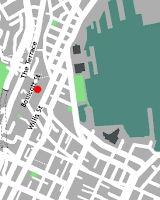Urban Eye: 66 Boulcott St
 Temporary, removable townhouses over an inner-city carpark.
Temporary, removable townhouses over an inner-city carpark.Urbanism +2
In many ways, this development should score very poorly for urbanism. It's purely residential in function, and at the sort of density that would be appropriate for inner suburbs, not a CBD street full of office and apartment blocks that range from 6 to 20 storeys.
 However, when one realises that this is a temporary use of airspace above a carpark, it's possible to see it as a clever solution to a common urban problem. The owner plans to wait until the commercial property market picks up before developing offices on the site, and the usual decision would be to leave this as a carpark. However, by building modular units and elevating them above the carpark on columns, the unused airspace gains a useful and viable urban function while retaining the current ground use and access to the offices behind. When conditions are right to build more permanently, the units can be moved elsewhere, beginning another life as ordinary suburban townhouses.
However, when one realises that this is a temporary use of airspace above a carpark, it's possible to see it as a clever solution to a common urban problem. The owner plans to wait until the commercial property market picks up before developing offices on the site, and the usual decision would be to leave this as a carpark. However, by building modular units and elevating them above the carpark on columns, the unused airspace gains a useful and viable urban function while retaining the current ground use and access to the offices behind. When conditions are right to build more permanently, the units can be moved elsewhere, beginning another life as ordinary suburban townhouses. Thus, this project scores well for adaptability. The residents of the 22 apartments also bring a modicum of after-hours life to an otherwise mainly 9-to-5 street. Above all, when compared to that most anti-urban of land uses, surface carparking, it's hard not to regard this as an improvement.
Thus, this project scores well for adaptability. The residents of the 22 apartments also bring a modicum of after-hours life to an otherwise mainly 9-to-5 street. Above all, when compared to that most anti-urban of land uses, surface carparking, it's hard not to regard this as an improvement.Aesthetics +1
When first built, these apartments featured in a newspaper article as the poster child for "ugly high-density housing". They are certainly neither beautiful nor cutting edge, and their unapologetically temporary materials were bound to raise the hackles of those who equate permanence with respectability. To my taste, the most unappealing element is the cheesy orange cladding, reminiscent of suburban pseudo-Tuscan McMansions.
 But at least a certain amount of effort has gone into detailing, especially around the entranceways, and there's a bit of token landscaping. The units could have been much better, but they are certainly much more attractive than the barren asphalt on which they're built.
But at least a certain amount of effort has gone into detailing, especially around the entranceways, and there's a bit of token landscaping. The units could have been much better, but they are certainly much more attractive than the barren asphalt on which they're built.Environment +1
There are no explicit measures to promote sustainability, though the fact that they are designed to be re-used is a plus. Their main environmental virtue is the fact that these 22 units house a population that would have taken two hectares of greenfield land and made 44 car journeys a day if they had followed the usual suburban pattern.
Social 0
These are not cheap apartments, so they can't be said to be adding to the social diversity of the area. They seem to be aimed at short-let accommodation for travelling executives and professionals, so they will do little to promote a sense of community. However, there are no existing residents or businesses to displace, so they should do no social harm.


0 Comments:
Post a Comment
<< Home